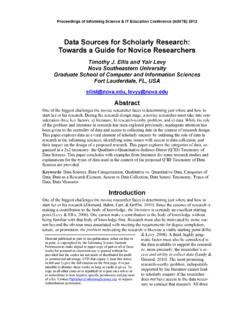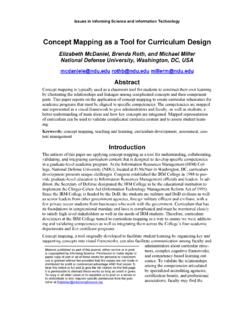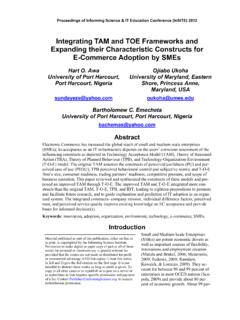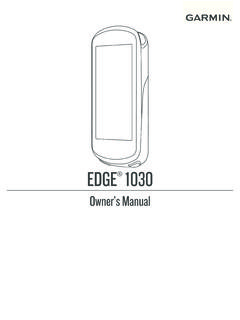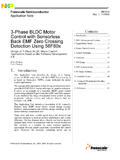Transcription of A Descriptive Algorithm for Sobel Image Edge …
1 Proceedings of Informing Science & IT Education Conference (InSITE) 2009 A Descriptive Algorithm for Sobel Image Edge detection O. R. Vincent, Clausthal University of Technology, Germany and University of Agriculture, Abeokuta, Nigeria @ O. Folorunso Department of Computer Science, University of Agriculture, Abeokuta, Nigeria folorunsolusegun@ Abstract Image edge detection is a process of locating the edge of an Image which is important in finding the approximate absolute gradient magnitude at each point I of an input grayscale Image . The problem of getting an appropriate absolute gradient magnitude for edges lies in the method used. The Sobel operator performs a 2-D spatial gradient measurement on images. Transferring a 2-D pixel array into statistically uncorre lated data set enhances the removal of redundant data, as a result, reduction of the amount of data is required to represent a digital Image .
2 The Sobel edge detector uses a pair of 3 x 3 convolution masks, one estimating gradient in the x-direction and the other estimating gradient in y direction. The Sobe l detector is incredibly sensitive to noise in pic-tures, it effectively highlight them as edges . Hence, Sobel operator is recommended in massive data communication found in data transfer. Ke ywords: Image Processing, Edge detection , Sobe l Operator, Data Communication and Absolute Gradient Magnitude. Introduction Image processing is important in modern data storage and data transmission especially in progressive transmiss ion of images, video coding (teleconferencing), digital libraries, and Image database, remote sensing. It has to do with manipulation of images done by Algorithm to produce desired images (Milan et al.)
3 , 2003). Digita l Signal Processing (DSP) improve the quality of im-ages taken under extremely unfavourable conditions in several ways: brightness and contrast ad-justment, edge detection , noise reduction, focus adjustment, motion blur reduction etc (Gonza lez, 2002). The advantage is that Image processing allows much wider range of algorithms to be ap-plied to the input data in order to avoid problems such as the build-up of noise and signa l distor-tion during processing (Baker & Nayar, 1996). Many of the techniques of digita l Image process-ing were developed in the 1960's at the Jet Propulsion Laboratory, Massachusetts Institute of Technology (MIT), Bell laboratory and few other places. But the cost of proc-essing was fairly high w ith the comput-ing equipments of that era.
4 With the fast computers and signal processors available in the 2000's, digi-tal Image processing became the most common form of Image processing and is general used because it is not only the most versatile method but also the M aterial p ublished as p art of this p ublication, either on-lin e or in p rint, is copy righted by the Informing Scien ce Institute. Permission to make digital or p ap er copy of p art or all of these works for p ersonal or classroom use is granted without fee p rovided that the cop ies are not made or distributed for p rofit or commer cial advantage AND that cop ies 1) bear this notice in full and 2) give the full citation on the first p age. It is p er-missible to abstract these works so long as cred it is giv en.
5 To copy in all other cases or to rep ublish or to p ost on a server or to redistribute to lists requires sp ecific p ermission and p ay ment of a fee. Contact Publisher@Informin g to request redistribution p ermission. A Descripti ve Algorit hm for Sobel Im age Edge detection 98 cheapest. The process allows the use of much more complex a lgorithms for Image processing and hence can offer both more sophisticated performance at simple tasks, and the implementation of methods which would be impossible by analog means (Micheal, 2003). Thus, images are stored on the computers as collection of bits representing pixel or points forming the picture elements (Vincent, 2006). Firstly, images are a measure of parameter over space, while most s igna ls are measures of parameter over time.
6 Secondly, they contain a great deal of information (Guthe & Strasser, 2004); Image processing is any form of information processing for which the input is an Image , such as frames of video; the output is not necessarily an Image , but can be for instance be a set of features of the Image (Yuval, 1996). Most Image -processing techniques involve treating the Image as a two-dimensional s ignal and applying standard signal-processing techniques to it. The process involves the enhancement or manipulation of an Image which resulted in another Image , remova l of redundant data and the transformation of a 2-D pixe l array into a statically uncorre lated data set (Priotr, 2004). Since images contain lots of redundant data, scholars have discovered that the most important information lies in it edges (Canny, 1986).
7 edges being the local property of a pixel and its im-mediate neighbourhood, characterizes boundary (Chaug-Huang, 2002). They correspond to object boundaries, changes in surface orientation and describe defeat by a small margin. edges typically correspond to points in the Image where the gray value changes significantly from one pixel to the next. edges represents region in the Image with strong intensity contrast; representing an im-age by its edges has the fundamental advantage that the amount of data is reduced significantly while retaining most of Image s vital information with high frequencies (Keren, Osadchy, & Gotsman, 2001). Thus, detecting edges help in extracting useful information characteristics of the Image where there are abrupt changes (Folorunso et al.)
8 , 2007). Edge detection is a process of locating an edge of an Image . detection of edges in an Image is a very important step towards understanding Image features. edges consist of meaningful features and contained significant information. It s reduce significantly the amount of the Image size and filters out information that may be regarded as less relevant, preserving the important structural properties of an Image (Yuval, 1996). Most images contain some amount of redundancies that can sometimes be removed when edges are detected and replaced, when it is reconstructed (Osuna et al., 1997). Eliminating the redundancy could be done through edge detection . When Image edges are detected, every kind of redundancy present in the Image is removed (Sparr, 2000).
9 The purpose of detecting sharp changes in Image brightness is to capture important events. Applying an edge detector to an Image may significantly reduce the amount of data to be processed and may therefore filter out information that may be regarded as less relevant, while preserving the important structural properties of an Image . The Image quality reflects significant information in the output edge and the size of the Image is reduced. This in turn explains further that edge detection is one of the ways of solving the problem of high volume of space images oc-cupy in the computer memory. The problems of storage, transmission over the Internet and bandwidth could be solved when edges are detected (Vincent, 2007). Since edges often occur at Image locations representing object boundaries, edge detection is extensively used in Image seg-mentation when images are divided into areas corresponding to different objects.
10 Related Methods Different methods are used to detect edges in Image processing among these is Roberts Cross Al-gorithms. Robert process a photograph into a line drawing, transform the line drawing into a three-dimens iona l representation and finally display the three-dimens iona l structure with all the hidden lines removed, from any point of view (Robert, 1965). The Roberts cross Algorithm (Mario& Maltoni, 1997) performs a 2-D spatial gradient convolution on the Image . The main idea is to bring out the horizonta l and vertical edges individually and then to put them together for the Vincent & Folorunso 99 resulting edge detection . The two filters highlight areas of high special frequency, which tend to define the edge of an object in an Image .

